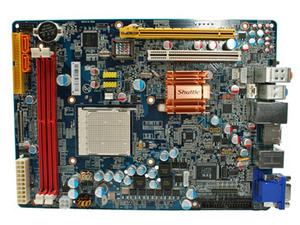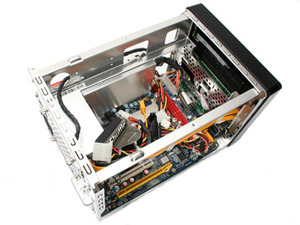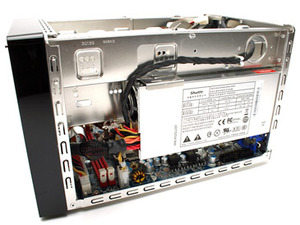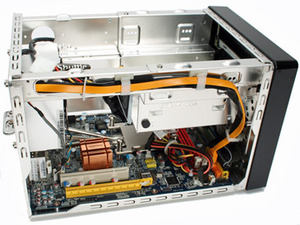Getting in is easy – three thumbscrews at the back and the cover comes off. Then internally it's exactly the same as all previous G-series Shuttle XPCs – the main aluminium compartment that holds the optical drive and both 3.5" bays comes out in one and the ICE system is easily removed with a Philips screwdriver. It's not as tidy as a typical P-series chassis, and I still feel there could be some design improvements – like moving the SATA to the back and dropping the IDE altogether, but the cable routing is still excellent considering the space available.
Inside you get two DDR2 memory slots and you'll want to populate both for dual channel. Thankfully 2GB kits cost next to nothing these days and 4GB pairs (2x2GB) are coming down in price all the time. If you are using one for the HTPC though, even on a budget you could easily get away with just one 1GB module, even in Windows Vista Media Center. Dual channel memory doesn't offer that much more on an Athlon 64 system, especially not for (HD) video playback.
The single chipset IGP is passively cooled by a tiny heatsink – something we're not used to seeing from Nvidia it has to be said. If you're not using the IGP it'll automatically turn itself off when you use the PCI-Express x16 graphics slot (or even a PCI-based graphics card). You can do quad display even if you use another Nvidia graphics card, although bearing in mind one will have to be connected to VGA (as opposed to the now common digital connections).
Because of the design of the G5-series chassis you can't use a dual height (dual-width) graphics card, so you're limited to single slot solutions like the AMD ATI Radeon HD 3850. Unfortunately though, the system can't handle an Nvidia GeForce 8800 GT because there's just too much power draw. The PCI slot allows further expansion but if you need to use a PCI-Express x1 slot there is only the option of the full x16. While it obviously uses up this slot so a graphics card can't be used, PCI-Express backward compatibility works wonderfully in this situation – we tested the latest Asus Xonar D2X PCI-Express x1 sound card in the x16 slot and it worked perfectly.
 The motherboard features all solid aluminium capped capacitors, which, given the typically hotter internal environment they will be subjected to, should mean they are a more worthy inclusion than they are on a full-sized ATX board.
The motherboard features all solid aluminium capped capacitors, which, given the typically hotter internal environment they will be subjected to, should mean they are a more worthy inclusion than they are on a full-sized ATX board.
Unlike the SP35P2 Pro, there is no cooling on the power regulation components, so all the heat generated from the three phases is diverted directly back into the motherboard – they get extremely hot when the CPU is loaded. A hotter motherboard affects the resistance of the thin copper traces and causes additional errors – if I was buying this chassis, I'd look at epoxying some heatsinks to the top of the PWMs.
The board looks good and has colour differentiated slots like so many others today – it seems funny because you'll never see it, but it also reaffirms Shuttle’s attention to detail—both inside and out--on its products.
Included on the board are a single Physical Layer Gigabit Ethernet and the more expensive Realtek ALC888DD – this is an absolute plus for a potential HTPC. It's awesome that Shuttle didn't drop back to the bog-standard ALC888 for the non-Deluxe model just to save a few – the core motherboard is identical on both the G6 Deluxe and PTG5.
Inside you get two DDR2 memory slots and you'll want to populate both for dual channel. Thankfully 2GB kits cost next to nothing these days and 4GB pairs (2x2GB) are coming down in price all the time. If you are using one for the HTPC though, even on a budget you could easily get away with just one 1GB module, even in Windows Vista Media Center. Dual channel memory doesn't offer that much more on an Athlon 64 system, especially not for (HD) video playback.
The single chipset IGP is passively cooled by a tiny heatsink – something we're not used to seeing from Nvidia it has to be said. If you're not using the IGP it'll automatically turn itself off when you use the PCI-Express x16 graphics slot (or even a PCI-based graphics card). You can do quad display even if you use another Nvidia graphics card, although bearing in mind one will have to be connected to VGA (as opposed to the now common digital connections).
Because of the design of the G5-series chassis you can't use a dual height (dual-width) graphics card, so you're limited to single slot solutions like the AMD ATI Radeon HD 3850. Unfortunately though, the system can't handle an Nvidia GeForce 8800 GT because there's just too much power draw. The PCI slot allows further expansion but if you need to use a PCI-Express x1 slot there is only the option of the full x16. While it obviously uses up this slot so a graphics card can't be used, PCI-Express backward compatibility works wonderfully in this situation – we tested the latest Asus Xonar D2X PCI-Express x1 sound card in the x16 slot and it worked perfectly.
 The motherboard features all solid aluminium capped capacitors, which, given the typically hotter internal environment they will be subjected to, should mean they are a more worthy inclusion than they are on a full-sized ATX board.
The motherboard features all solid aluminium capped capacitors, which, given the typically hotter internal environment they will be subjected to, should mean they are a more worthy inclusion than they are on a full-sized ATX board. Unlike the SP35P2 Pro, there is no cooling on the power regulation components, so all the heat generated from the three phases is diverted directly back into the motherboard – they get extremely hot when the CPU is loaded. A hotter motherboard affects the resistance of the thin copper traces and causes additional errors – if I was buying this chassis, I'd look at epoxying some heatsinks to the top of the PWMs.
The board looks good and has colour differentiated slots like so many others today – it seems funny because you'll never see it, but it also reaffirms Shuttle’s attention to detail—both inside and out--on its products.
Included on the board are a single Physical Layer Gigabit Ethernet and the more expensive Realtek ALC888DD – this is an absolute plus for a potential HTPC. It's awesome that Shuttle didn't drop back to the bog-standard ALC888 for the non-Deluxe model just to save a few – the core motherboard is identical on both the G6 Deluxe and PTG5.

MSI MPG Velox 100R Chassis Review
October 14 2021 | 15:04













Want to comment? Please log in.